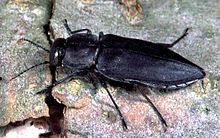Pyrophile

A pyrophile or pyrophilic/pyrophilous insect is an insect which has evolved to rely upon fire ecology for important parts of their life cycle. Pyrophiles usually occur alongside and co-evolve with pyrophytes, the plant analog of a pyrophilic insect - those plants which rely upon natural fires as part of their lifecycle.
These insects have evolved to be able to rapidly colonize environments after a wildfire. Highly sensitive infrared receptors are thought to have evolved independently in at least four different groups of insects.[1]
Little is known about the ecological interactions and consequences of pyrophilic insects, though they are known mostly amongst flies and beetles.[2] Flies of the genus Microsania are some of the most numerous and well-described pryophilic insects. Others include buprestid beetles in the genus Melanophila, ground beetles in the genus Sericoda, and some species of flat bugs in the genus Aradus.
Various theories explain these fire-loving adaptations as owing to the weakening of the host plant, the sterilization of the medium into which the eggs are laid, or the elimination of competitive or predatory organisms.
References[edit]
- ^ Hoang, TP (2019). "Adaptations of pyrophilous insects to burnt habitats: Odor signals, infrared receptors and behavior". PhD Thesis.
- ^ Bell, Aaron, J.; Calladine, Kiara, S.; Wardle, David, A.; Phillips, Iain, D. (24 August 2022). "Rapid colonization of the post-burn environment improves egg survival in pyrophilic ground beetles". Ecosphere. 13 (8). doi:10.1002/ecs2.4213.
{{cite journal}}: CS1 maint: multiple names: authors list (link)
